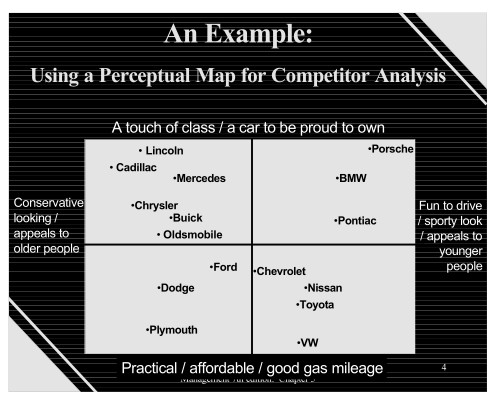Non-attribute methods–MDS (multi-dimensional scaling) – asks for individuals’ perceptions of similarity between objects (e.g., soap brands) and preferences among these objects in order to infer which characteristics were used to form the perceptions.
Multi dimensional Scaling (MDS) is a statistical technique used primarily in marketing and the social sciences. It is a procedure for taking the preferences and perceptions of respondents and representing them on a visual grid. These grids, called perceptual maps are usually two dimensional, but they can represent more than two. Potential customers are asked to compare pairs of products and make judgments about their similarity. MDS obtains the underlying dimensions from respondents’ judgments about the similarity of products. This is an important advantage. It does not depend on researchers’ judgments. It does not require a list of attributes to be shown to the respondents. The underlying dimensions come from respondents’ judgments about pairs of products. Because of these advantages, MDS is the most common technique used in perceptual mapping.
- The aim of multidimensional scaling (MDS) is to reproduce the perceived similarity between a Number of objects in low dimensional space.
- Technically, the objects are pushed back and forth in low dimensional space until their distances in this space reasonably reproduce the input similarity data (wherever those come from).
- The dimensions in MDS are often interpreted in the same way as factors in factor analysis. This is not quite correct – whereas factor analysis explains co variation between variables, MDS reproduces distances between objects.

Important Issues in using MDS
- Similarity and dissimilarity data (“product/brand space”)
- Preference data (“ideal points/segments”)
- Number of dimensions (factors) for the map
- How one labels the dimensions
- What gaps in the perceptual map mean

